Enterprise System and Data Management: A Comprehensive Report
VerifiedAdded on 2023/03/23
|6
|1468
|30
Report
AI Summary
This report delves into the realm of Enterprise Systems (ES) and Data Management, exploring their profound impact on business performance. The report begins by defining ES and its role in coordinating business activities and decision-making across an organization. It highlights the increasing significance of integrating ES, particularly Enterprise Resource Planning (ERP) systems, for automating operations and managing data. Facing increased competition, companies are adopting ES to reduce operational costs and improve efficiency. The report showcases the benefits of ES, including a unified enterprise view and a centralized database. The study investigates the impacts of implementing Enterprise Systems for database management in business performance through a case study of LG Inc. and peer-reviewed articles. The report reveals that LG utilized Oracle's ES to upgrade its data management techniques, leading to considerable advancements in its business. The document also reviews literature on the impact of ES in organizational operations, focusing on studies related to data management and the factors for successful ES implementation. The study highlights the importance of ES in data management, though it may not be as competitive for accounting and divisional performance. In conclusion, the report summarizes the benefits of ES and their crucial role in improving data management and overall business performance.
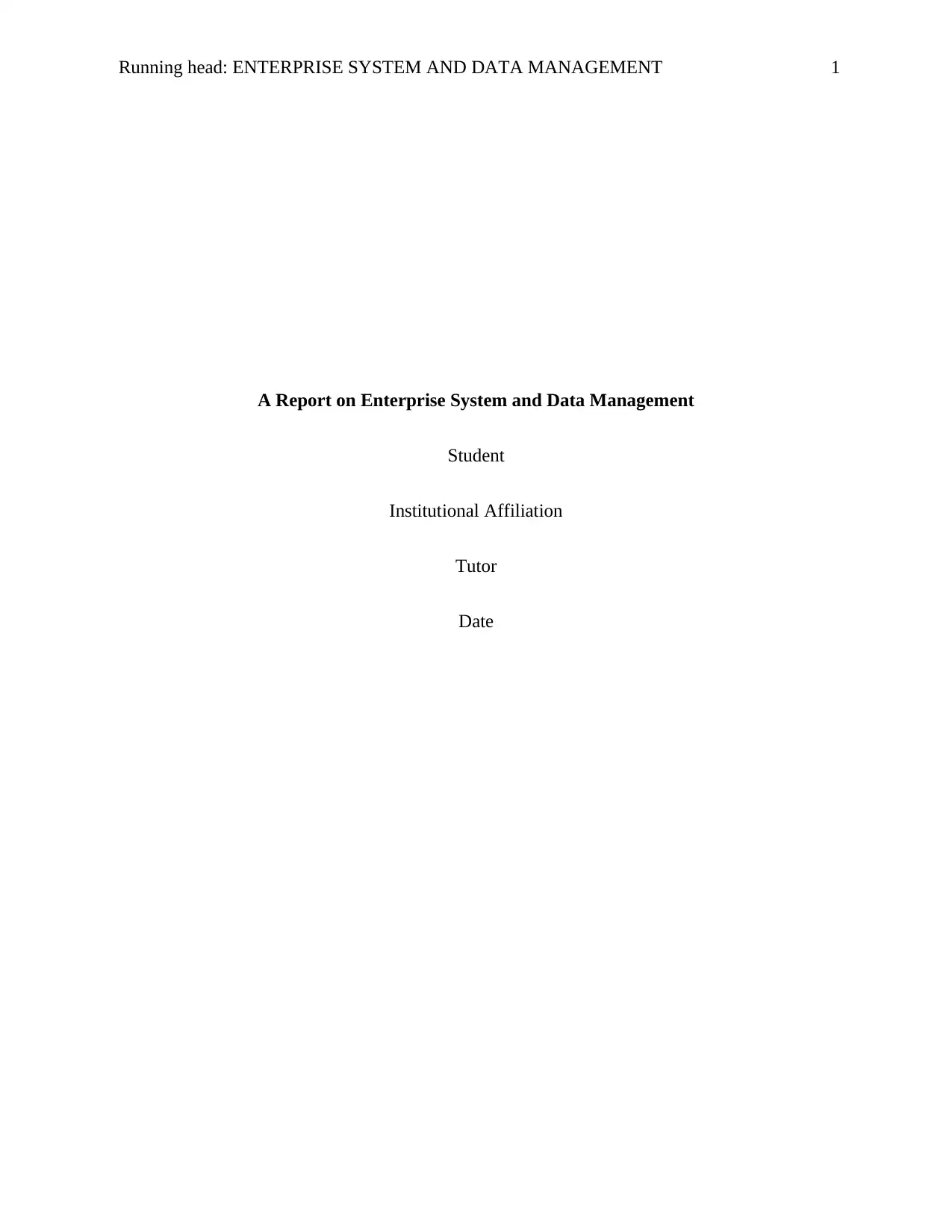
Running head: ENTERPRISE SYSTEM AND DATA MANAGEMENT 1
A Report on Enterprise System and Data Management
Student
Institutional Affiliation
Tutor
Date
A Report on Enterprise System and Data Management
Student
Institutional Affiliation
Tutor
Date
Paraphrase This Document
Need a fresh take? Get an instant paraphrase of this document with our AI Paraphraser
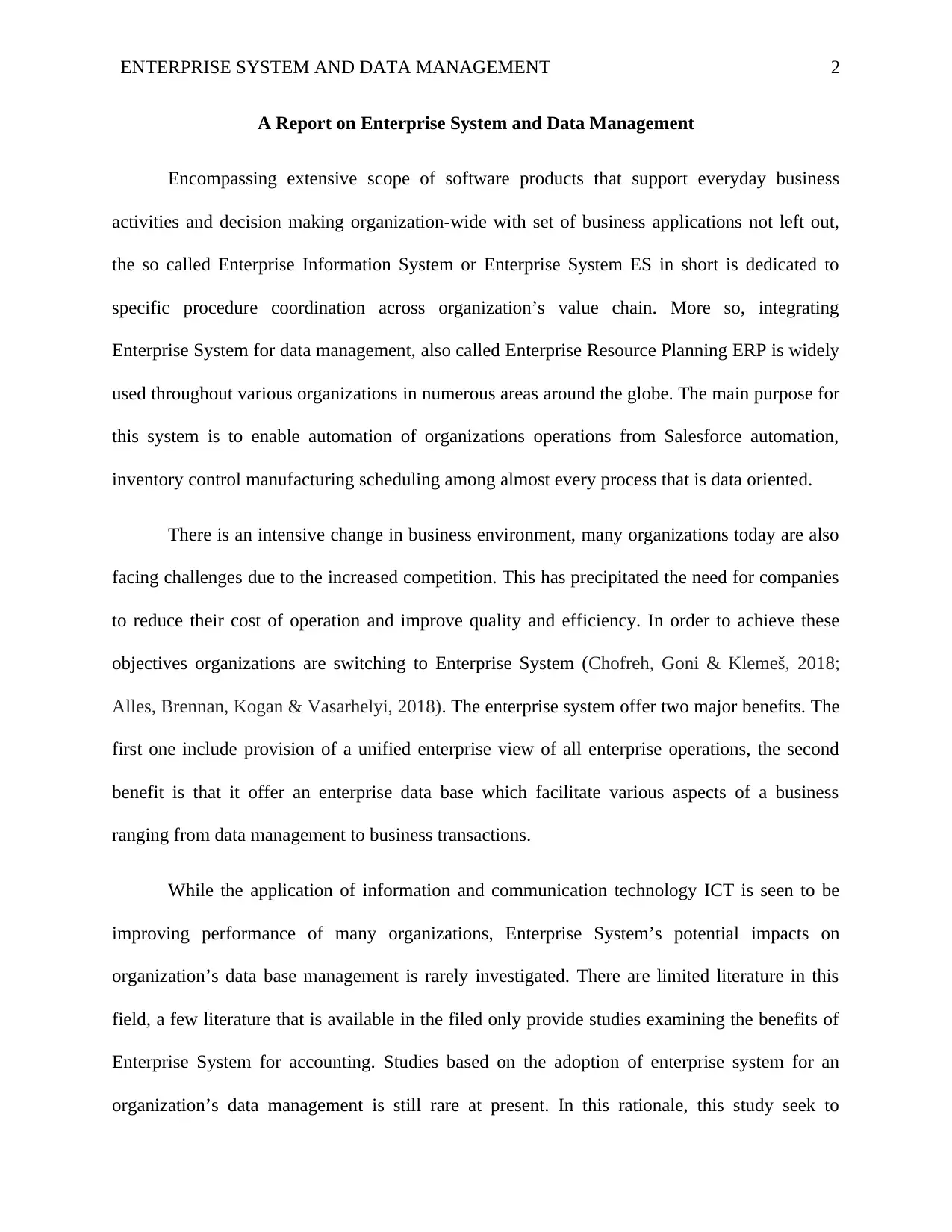
ENTERPRISE SYSTEM AND DATA MANAGEMENT 2
A Report on Enterprise System and Data Management
Encompassing extensive scope of software products that support everyday business
activities and decision making organization-wide with set of business applications not left out,
the so called Enterprise Information System or Enterprise System ES in short is dedicated to
specific procedure coordination across organization’s value chain. More so, integrating
Enterprise System for data management, also called Enterprise Resource Planning ERP is widely
used throughout various organizations in numerous areas around the globe. The main purpose for
this system is to enable automation of organizations operations from Salesforce automation,
inventory control manufacturing scheduling among almost every process that is data oriented.
There is an intensive change in business environment, many organizations today are also
facing challenges due to the increased competition. This has precipitated the need for companies
to reduce their cost of operation and improve quality and efficiency. In order to achieve these
objectives organizations are switching to Enterprise System (Chofreh, Goni & Klemeš, 2018;
Alles, Brennan, Kogan & Vasarhelyi, 2018). The enterprise system offer two major benefits. The
first one include provision of a unified enterprise view of all enterprise operations, the second
benefit is that it offer an enterprise data base which facilitate various aspects of a business
ranging from data management to business transactions.
While the application of information and communication technology ICT is seen to be
improving performance of many organizations, Enterprise System’s potential impacts on
organization’s data base management is rarely investigated. There are limited literature in this
field, a few literature that is available in the filed only provide studies examining the benefits of
Enterprise System for accounting. Studies based on the adoption of enterprise system for an
organization’s data management is still rare at present. In this rationale, this study seek to
A Report on Enterprise System and Data Management
Encompassing extensive scope of software products that support everyday business
activities and decision making organization-wide with set of business applications not left out,
the so called Enterprise Information System or Enterprise System ES in short is dedicated to
specific procedure coordination across organization’s value chain. More so, integrating
Enterprise System for data management, also called Enterprise Resource Planning ERP is widely
used throughout various organizations in numerous areas around the globe. The main purpose for
this system is to enable automation of organizations operations from Salesforce automation,
inventory control manufacturing scheduling among almost every process that is data oriented.
There is an intensive change in business environment, many organizations today are also
facing challenges due to the increased competition. This has precipitated the need for companies
to reduce their cost of operation and improve quality and efficiency. In order to achieve these
objectives organizations are switching to Enterprise System (Chofreh, Goni & Klemeš, 2018;
Alles, Brennan, Kogan & Vasarhelyi, 2018). The enterprise system offer two major benefits. The
first one include provision of a unified enterprise view of all enterprise operations, the second
benefit is that it offer an enterprise data base which facilitate various aspects of a business
ranging from data management to business transactions.
While the application of information and communication technology ICT is seen to be
improving performance of many organizations, Enterprise System’s potential impacts on
organization’s data base management is rarely investigated. There are limited literature in this
field, a few literature that is available in the filed only provide studies examining the benefits of
Enterprise System for accounting. Studies based on the adoption of enterprise system for an
organization’s data management is still rare at present. In this rationale, this study seek to
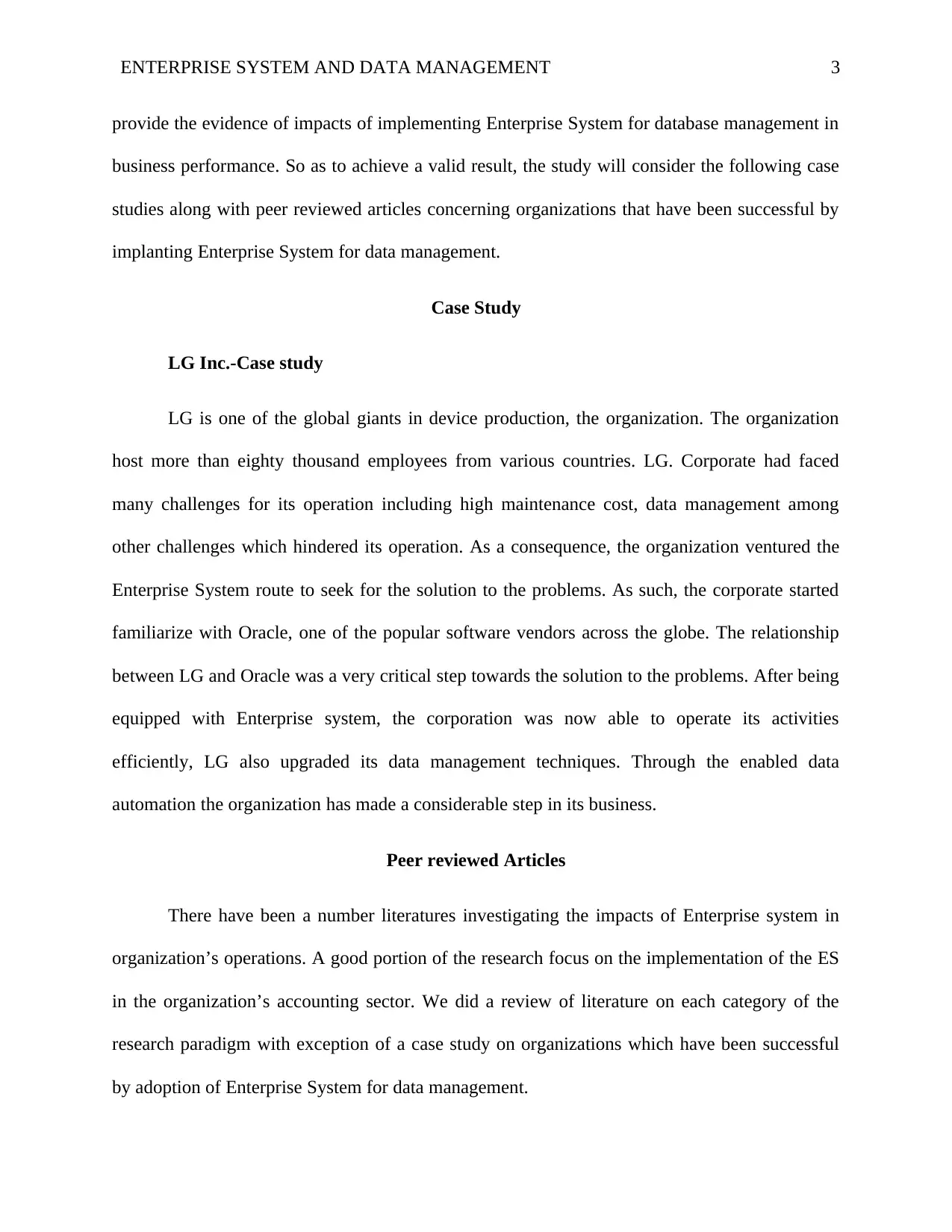
ENTERPRISE SYSTEM AND DATA MANAGEMENT 3
provide the evidence of impacts of implementing Enterprise System for database management in
business performance. So as to achieve a valid result, the study will consider the following case
studies along with peer reviewed articles concerning organizations that have been successful by
implanting Enterprise System for data management.
Case Study
LG Inc.-Case study
LG is one of the global giants in device production, the organization. The organization
host more than eighty thousand employees from various countries. LG. Corporate had faced
many challenges for its operation including high maintenance cost, data management among
other challenges which hindered its operation. As a consequence, the organization ventured the
Enterprise System route to seek for the solution to the problems. As such, the corporate started
familiarize with Oracle, one of the popular software vendors across the globe. The relationship
between LG and Oracle was a very critical step towards the solution to the problems. After being
equipped with Enterprise system, the corporation was now able to operate its activities
efficiently, LG also upgraded its data management techniques. Through the enabled data
automation the organization has made a considerable step in its business.
Peer reviewed Articles
There have been a number literatures investigating the impacts of Enterprise system in
organization’s operations. A good portion of the research focus on the implementation of the ES
in the organization’s accounting sector. We did a review of literature on each category of the
research paradigm with exception of a case study on organizations which have been successful
by adoption of Enterprise System for data management.
provide the evidence of impacts of implementing Enterprise System for database management in
business performance. So as to achieve a valid result, the study will consider the following case
studies along with peer reviewed articles concerning organizations that have been successful by
implanting Enterprise System for data management.
Case Study
LG Inc.-Case study
LG is one of the global giants in device production, the organization. The organization
host more than eighty thousand employees from various countries. LG. Corporate had faced
many challenges for its operation including high maintenance cost, data management among
other challenges which hindered its operation. As a consequence, the organization ventured the
Enterprise System route to seek for the solution to the problems. As such, the corporate started
familiarize with Oracle, one of the popular software vendors across the globe. The relationship
between LG and Oracle was a very critical step towards the solution to the problems. After being
equipped with Enterprise system, the corporation was now able to operate its activities
efficiently, LG also upgraded its data management techniques. Through the enabled data
automation the organization has made a considerable step in its business.
Peer reviewed Articles
There have been a number literatures investigating the impacts of Enterprise system in
organization’s operations. A good portion of the research focus on the implementation of the ES
in the organization’s accounting sector. We did a review of literature on each category of the
research paradigm with exception of a case study on organizations which have been successful
by adoption of Enterprise System for data management.
⊘ This is a preview!⊘
Do you want full access?
Subscribe today to unlock all pages.

Trusted by 1+ million students worldwide
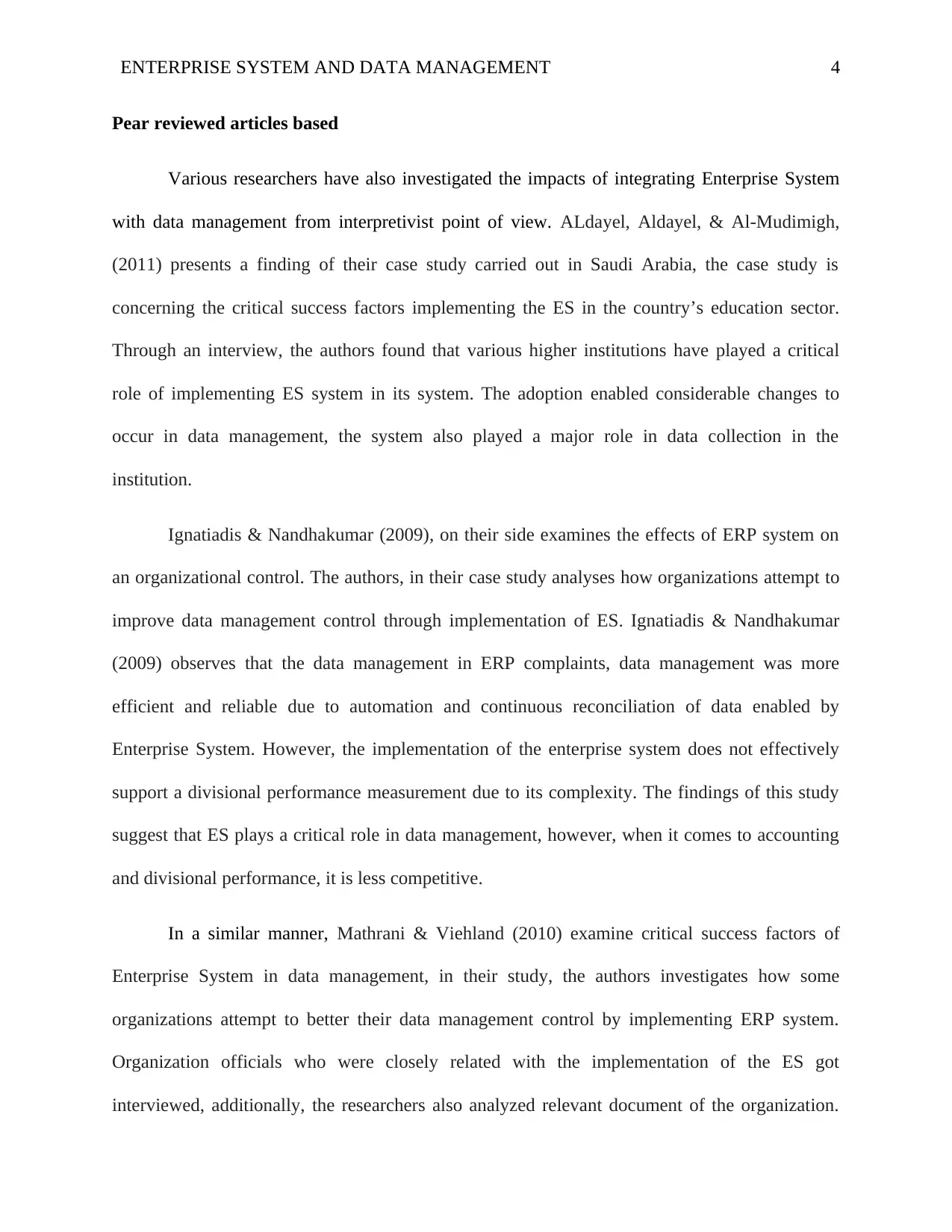
ENTERPRISE SYSTEM AND DATA MANAGEMENT 4
Pear reviewed articles based
Various researchers have also investigated the impacts of integrating Enterprise System
with data management from interpretivist point of view. ALdayel, Aldayel, & Al-Mudimigh,
(2011) presents a finding of their case study carried out in Saudi Arabia, the case study is
concerning the critical success factors implementing the ES in the country’s education sector.
Through an interview, the authors found that various higher institutions have played a critical
role of implementing ES system in its system. The adoption enabled considerable changes to
occur in data management, the system also played a major role in data collection in the
institution.
Ignatiadis & Nandhakumar (2009), on their side examines the effects of ERP system on
an organizational control. The authors, in their case study analyses how organizations attempt to
improve data management control through implementation of ES. Ignatiadis & Nandhakumar
(2009) observes that the data management in ERP complaints, data management was more
efficient and reliable due to automation and continuous reconciliation of data enabled by
Enterprise System. However, the implementation of the enterprise system does not effectively
support a divisional performance measurement due to its complexity. The findings of this study
suggest that ES plays a critical role in data management, however, when it comes to accounting
and divisional performance, it is less competitive.
In a similar manner, Mathrani & Viehland (2010) examine critical success factors of
Enterprise System in data management, in their study, the authors investigates how some
organizations attempt to better their data management control by implementing ERP system.
Organization officials who were closely related with the implementation of the ES got
interviewed, additionally, the researchers also analyzed relevant document of the organization.
Pear reviewed articles based
Various researchers have also investigated the impacts of integrating Enterprise System
with data management from interpretivist point of view. ALdayel, Aldayel, & Al-Mudimigh,
(2011) presents a finding of their case study carried out in Saudi Arabia, the case study is
concerning the critical success factors implementing the ES in the country’s education sector.
Through an interview, the authors found that various higher institutions have played a critical
role of implementing ES system in its system. The adoption enabled considerable changes to
occur in data management, the system also played a major role in data collection in the
institution.
Ignatiadis & Nandhakumar (2009), on their side examines the effects of ERP system on
an organizational control. The authors, in their case study analyses how organizations attempt to
improve data management control through implementation of ES. Ignatiadis & Nandhakumar
(2009) observes that the data management in ERP complaints, data management was more
efficient and reliable due to automation and continuous reconciliation of data enabled by
Enterprise System. However, the implementation of the enterprise system does not effectively
support a divisional performance measurement due to its complexity. The findings of this study
suggest that ES plays a critical role in data management, however, when it comes to accounting
and divisional performance, it is less competitive.
In a similar manner, Mathrani & Viehland (2010) examine critical success factors of
Enterprise System in data management, in their study, the authors investigates how some
organizations attempt to better their data management control by implementing ERP system.
Organization officials who were closely related with the implementation of the ES got
interviewed, additionally, the researchers also analyzed relevant document of the organization.
Paraphrase This Document
Need a fresh take? Get an instant paraphrase of this document with our AI Paraphraser
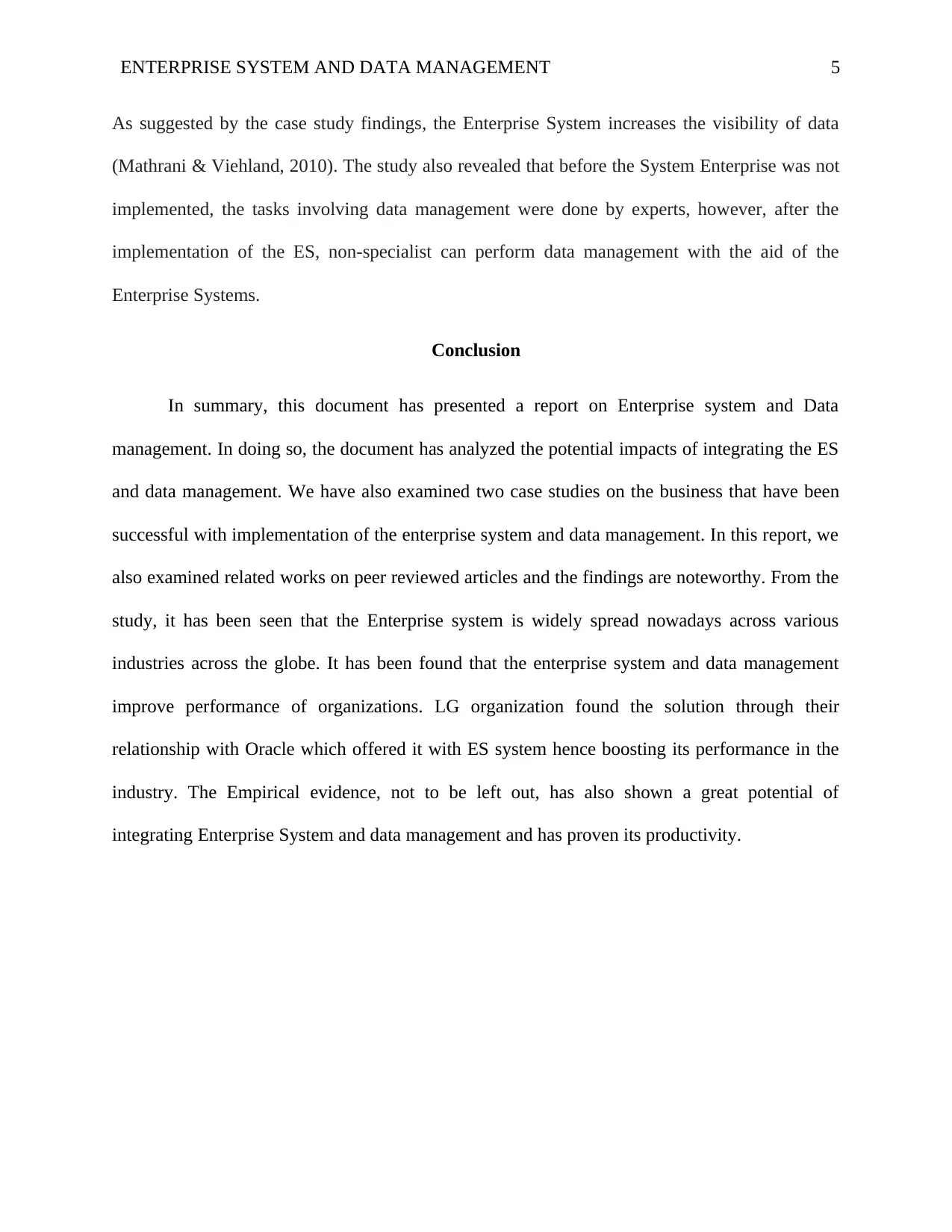
ENTERPRISE SYSTEM AND DATA MANAGEMENT 5
As suggested by the case study findings, the Enterprise System increases the visibility of data
(Mathrani & Viehland, 2010). The study also revealed that before the System Enterprise was not
implemented, the tasks involving data management were done by experts, however, after the
implementation of the ES, non-specialist can perform data management with the aid of the
Enterprise Systems.
Conclusion
In summary, this document has presented a report on Enterprise system and Data
management. In doing so, the document has analyzed the potential impacts of integrating the ES
and data management. We have also examined two case studies on the business that have been
successful with implementation of the enterprise system and data management. In this report, we
also examined related works on peer reviewed articles and the findings are noteworthy. From the
study, it has been seen that the Enterprise system is widely spread nowadays across various
industries across the globe. It has been found that the enterprise system and data management
improve performance of organizations. LG organization found the solution through their
relationship with Oracle which offered it with ES system hence boosting its performance in the
industry. The Empirical evidence, not to be left out, has also shown a great potential of
integrating Enterprise System and data management and has proven its productivity.
As suggested by the case study findings, the Enterprise System increases the visibility of data
(Mathrani & Viehland, 2010). The study also revealed that before the System Enterprise was not
implemented, the tasks involving data management were done by experts, however, after the
implementation of the ES, non-specialist can perform data management with the aid of the
Enterprise Systems.
Conclusion
In summary, this document has presented a report on Enterprise system and Data
management. In doing so, the document has analyzed the potential impacts of integrating the ES
and data management. We have also examined two case studies on the business that have been
successful with implementation of the enterprise system and data management. In this report, we
also examined related works on peer reviewed articles and the findings are noteworthy. From the
study, it has been seen that the Enterprise system is widely spread nowadays across various
industries across the globe. It has been found that the enterprise system and data management
improve performance of organizations. LG organization found the solution through their
relationship with Oracle which offered it with ES system hence boosting its performance in the
industry. The Empirical evidence, not to be left out, has also shown a great potential of
integrating Enterprise System and data management and has proven its productivity.
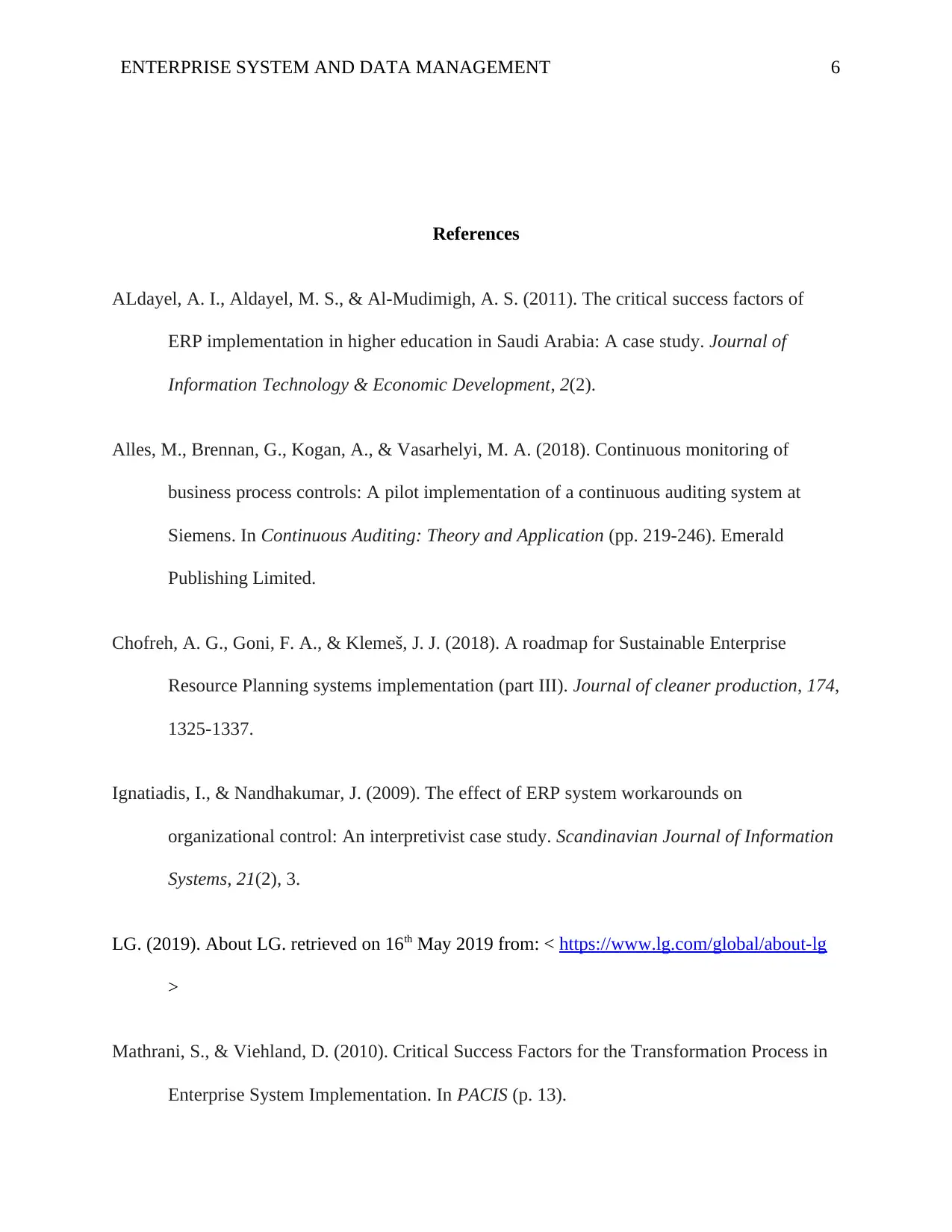
ENTERPRISE SYSTEM AND DATA MANAGEMENT 6
References
ALdayel, A. I., Aldayel, M. S., & Al-Mudimigh, A. S. (2011). The critical success factors of
ERP implementation in higher education in Saudi Arabia: A case study. Journal of
Information Technology & Economic Development, 2(2).
Alles, M., Brennan, G., Kogan, A., & Vasarhelyi, M. A. (2018). Continuous monitoring of
business process controls: A pilot implementation of a continuous auditing system at
Siemens. In Continuous Auditing: Theory and Application (pp. 219-246). Emerald
Publishing Limited.
Chofreh, A. G., Goni, F. A., & Klemeš, J. J. (2018). A roadmap for Sustainable Enterprise
Resource Planning systems implementation (part III). Journal of cleaner production, 174,
1325-1337.
Ignatiadis, I., & Nandhakumar, J. (2009). The effect of ERP system workarounds on
organizational control: An interpretivist case study. Scandinavian Journal of Information
Systems, 21(2), 3.
LG. (2019). About LG. retrieved on 16th May 2019 from: < https://www.lg.com/global/about-lg
>
Mathrani, S., & Viehland, D. (2010). Critical Success Factors for the Transformation Process in
Enterprise System Implementation. In PACIS (p. 13).
References
ALdayel, A. I., Aldayel, M. S., & Al-Mudimigh, A. S. (2011). The critical success factors of
ERP implementation in higher education in Saudi Arabia: A case study. Journal of
Information Technology & Economic Development, 2(2).
Alles, M., Brennan, G., Kogan, A., & Vasarhelyi, M. A. (2018). Continuous monitoring of
business process controls: A pilot implementation of a continuous auditing system at
Siemens. In Continuous Auditing: Theory and Application (pp. 219-246). Emerald
Publishing Limited.
Chofreh, A. G., Goni, F. A., & Klemeš, J. J. (2018). A roadmap for Sustainable Enterprise
Resource Planning systems implementation (part III). Journal of cleaner production, 174,
1325-1337.
Ignatiadis, I., & Nandhakumar, J. (2009). The effect of ERP system workarounds on
organizational control: An interpretivist case study. Scandinavian Journal of Information
Systems, 21(2), 3.
LG. (2019). About LG. retrieved on 16th May 2019 from: < https://www.lg.com/global/about-lg
>
Mathrani, S., & Viehland, D. (2010). Critical Success Factors for the Transformation Process in
Enterprise System Implementation. In PACIS (p. 13).
⊘ This is a preview!⊘
Do you want full access?
Subscribe today to unlock all pages.

Trusted by 1+ million students worldwide
1 out of 6
Related Documents
Your All-in-One AI-Powered Toolkit for Academic Success.
+13062052269
info@desklib.com
Available 24*7 on WhatsApp / Email
![[object Object]](/_next/static/media/star-bottom.7253800d.svg)
Unlock your academic potential
Copyright © 2020–2025 A2Z Services. All Rights Reserved. Developed and managed by ZUCOL.





